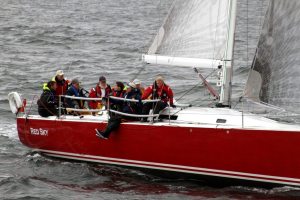The Nautical Advisory Council of the Port Washington Public Library sponsored an interesting evening called “Environmental Issues and Long Island Sound.” Long Island Sound Outreach Coordinator at NY Sea Grant Amy Mandelbaum and Joel Ziev, a Long Island Sound Citizens Advisory member, explained the latest conservation efforts to protect the health of the Long Island Sound ecosystem. Mandelbaum focused on several topics: marine debris, stormwater runoff, green infrastructure, safe seafood and wastewater treatment. Mandelbaum and Ziev described the Comprehensive Conservation and Management Plan, which addressed new environmental challenges while emphasizing sustainability, climate change resilience and environmental justice. They mentioned that everyone in the audience can help clean and maintain the waters on the Sound and Manhasset Bay. What can you do? 1. Keep the Sound clean, 2. Maintain septic systems, 3. Reduce, recycle and reuse, 4. Conserve water and energy, 5. Use organic lawn care techniques, 6. Buy and plant native plants and 7. Reduce runoff (if it gets into the ground, it goes into the water).
A table was set up with brochures and position papers to help understand what you can do to help. Two were especially informative: The Long Island Sound Comprehensive Conservation and Management Plan 2015: Returning the Urban Sea to Abundance, a Public Summary and Sound Update: Newsletter of the Long Island Sound Study. 


The Long Island Sound Study (LISS), a partnership led by Connecticut, New York and the U.S. Environmental Protection Agency (EPA), was launched in the 1980s to investigate the problems plaguing Long Island Sound at the time, including fill kills, degraded shoreline habitats and polluted beaches. In 1994, Connecticut, New York and the EPA approved a Long Island Sound Comprehensive Conservation and Management Plan (CCMP) to restore and protect the health of Long Island Sound. Today, much has improved through the partners’ water quality, stewardship and habitat restoration initiatives. But more still needs to be done. That is why LISS has revised the plan, proposing new actions and developing ecosystem targets for the next 20 years to fulfill LISS’s mission to restore and protect the Sound. The complete plan is available at www.longislandsoundstudy.net.
Other websites include: www.epa.gov, www.ct.gov/deep, www.dec.ny.gov, www.seagrant.uconn.edu and www.nyseagrant.org.
A booklet called Water Watch: What Boaters Can Do To Be Environmentally Friendly seemed especially relevant. According to the booklet, “Every action a boater makes impacts others sharing the waterway, the water itself, marine life and the near-shore and shoreline ecosystem and inhabitants. In almost all cases, a commonsense approach while boating will help protect the aquatic environment.” The booklet lists the “Top Ten” Eco-Boating Practices: 1. Observe local and federal marine toilet rules, 2. Always pump out on shore if you have a holding tank, 3. Know and use legal bottom paints, 4. Use biodegradable cleaning agents when possible, 5. Don’t litter on water. Bring it home. 6. When fueling, don’t top tanks and mop up fuel spills. 7. Watch your wake and propeller wash, 8. Keep your motors finely tuned, 9. Control your bilge water and 10. If fishing, practice “catch and release.”

Clean water is the foundation for enjoyable boating. It’s up to those who appreciate and recognize the privilege of using the waterways to protect this resource now and for future generations. (Source: The Foundation for Recreational Boating Safety & Education, The Environmental Council for the Boating Industry, National Marine Manufacturers Association, 200 E. Randolph Dr. #5100, Chicago, IL 60601-6528.)
The Environmental and Long Island Sound presentation was the first of three events sponsored by NAC. The next is Nautical History of Long Island Sound on Thursday, Feb. 25, at 7:30 p.m., eco-photo explorers will present a multimedia program examining shipwrecks from throughout Long Island’s history, from the Revolutionary War through modern times, including photos of what these wrecks look like today and what types of marine life inhabit them. Then on Thursday, March 31, at 7:30 p.m. members of Port Rowing will provide a visual presentation of their organization and their various programs.
Port Rowing encourages participation from juniors to adults, including rowers with special needs.
All the programs are at the library and are free and open to the public. For more information go to www.pwpl.org.































